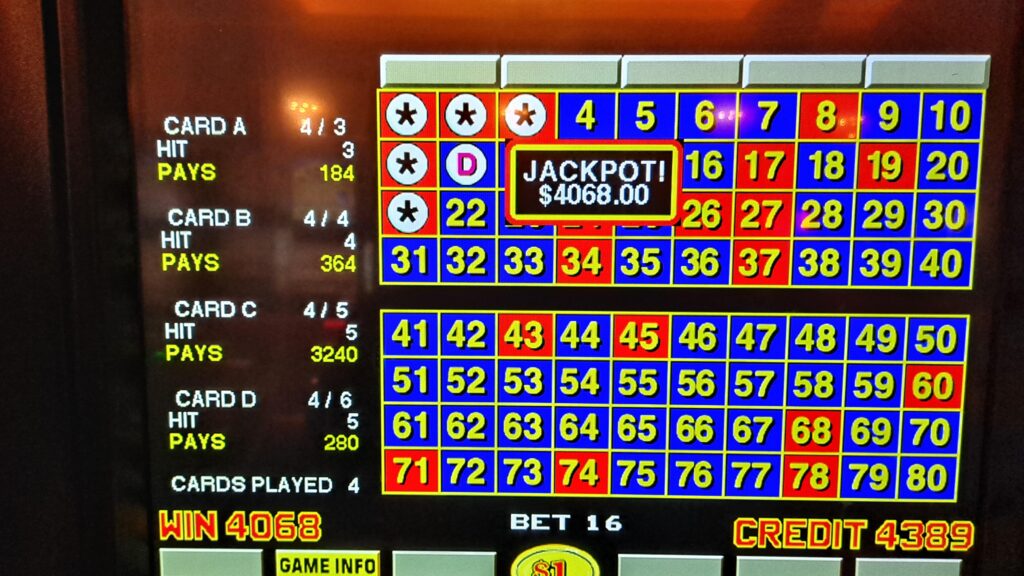Embarking on the thrilling journey of casino games, Keno stands out as a unique blend of lottery-style chance and casino excitement, and understanding the nuances of its rules, like the Spinning Wheel Rule, can significantly enhance a player's experience and strategy.
Understanding the Basics of Keno
Keno, often likened to a lottery but played at a much faster pace, is a game of chance where players select numbers from a grid, typically ranging from 1 to 80. After players make their selections and place their bets, 20 numbers are randomly drawn, usually by an automated system. The objective is simple: the more numbers a player correctly matches to the drawn numbers, the higher their payout. This simplicity is part of Keno's broad appeal, making it accessible to both novice and seasoned gamblers.
The game's origins trace back to ancient China, with stories suggesting it helped fund the construction of the Great Wall. Modern Keno, as we know it, evolved in the 19th century when Chinese immigrants brought the game to the Western world. Today, it's a staple in casinos worldwide and online gaming platforms, offering various formats and betting options.
Key elements of Keno include:
- The Keno Board (or Ticket): A grid of numbers from 1 to 80.
- Number Selection: Players choose a set of numbers, known as 'spots'. The number of spots can vary, typically from 1 to 20, depending on the casino's rules and player preference.
- The Draw: Twenty numbers are randomly drawn from the 80 available.
- Payouts: Determined by the number of spots matched and the amount wagered. Payout structures vary widely between casinos, significantly impacting the game's strategy and potential returns.
While Keno is fundamentally a game of chance, understanding its mechanics and payout structures is crucial for making informed betting decisions. For players looking to delve deeper into strategic play, exploring specific rules like the Spinning Wheel Rule can add an intriguing layer to their Keno experience.
Delving into the Spinning Wheel Rule in Keno
The Spinning Wheel Rule in Keno introduces an exciting variation to the traditional game, injecting an element of unpredictability and enhanced winning potential. Unlike standard Keno, where numbers are drawn directly, this rule incorporates a spinning wheel to determine a multiplier or bonus, adding an extra layer of anticipation and potential reward. It’s important to note that the Spinning Wheel Rule is not a universal feature of Keno but a specific variation found in certain casinos or Keno game versions, often in electronic or video Keno formats.
Here’s how the Spinning Wheel Rule generally works:
- Standard Keno Play: Initially, the game proceeds like regular Keno. Players select their numbers and place their bets.
- Number Draw: Twenty numbers are drawn from the standard pool of 80.
- Triggering the Spinning Wheel: The activation of the spinning wheel usually depends on certain game conditions. This could be triggered by achieving a specific number of matches, reaching a bonus round, or even randomly at the end of a standard draw. The trigger mechanism varies depending on the specific Keno game and casino rules.
- The Spinning Wheel: Once triggered, a virtual or mechanical spinning wheel appears. This wheel is divided into segments, each representing different multipliers or bonus payouts. These segments can range from small multipliers (like 2x or 3x) to significantly larger ones (such as 10x, 20x, or even higher), or special bonus prizes.
- Multiplier or Bonus Application: The wheel spins and lands on a segment, which determines the multiplier or bonus applied to the player's winnings from the base Keno game. For example, if a player wins $50 in the regular Keno draw and the wheel lands on a 4x multiplier, their total winnings become $200.
The Spinning Wheel Rule fundamentally alters the risk-reward dynamic of Keno. It offers the potential for significantly amplified payouts, making smaller wins more substantial and large wins potentially enormous. However, it also introduces an element of chance regarding whether and how much the winnings will be multiplied. This rule adds excitement and volatility, appealing to players seeking a more dynamic and potentially more rewarding Keno experience.
Variations and Types of Spinning Wheel Keno Games
Spinning Wheel Keno isn't a monolithic game; it comes in various forms, each offering unique twists on the basic rule, enhancing player engagement and strategic considerations. These variations ensure that the game remains fresh and appealing to diverse player preferences. Understanding these types is crucial for players to choose a game that aligns with their risk appetite and strategic inclinations.
Key variations include:
- Multiplier Wheel Keno: This is the most common type. After a qualifying win in the base Keno game, a spinning wheel is activated. The wheel is segmented with various multipliers that can significantly increase the player's winnings. For instance, wins could be multiplied by 2x, 5x, 10x, or even more, depending on the wheel's configuration. The trigger for the wheel and the range of multipliers vary by game.
- Bonus Wheel Keno: In this variation, the spinning wheel offers not just multipliers but also bonus prizes. Segments on the wheel might include instant cash prizes, free games, or entries into a progressive jackpot. Bonus Wheel Keno adds layers of potential rewards beyond simple win multiplication.
- Progressive Jackpot Wheel Keno: This combines the spinning wheel with a progressive jackpot. A segment on the wheel offers a chance to win a jackpot that grows with each game played until it’s won. This type offers the allure of a very large payout, in addition to regular multipliers and bonuses.
- Random Trigger Wheel Keno: Some games feature a randomly triggered spinning wheel. In these versions, the wheel can activate at any point during gameplay, regardless of the outcome of the Keno draw itself. This introduces an element of surprise, as the wheel could spin even after a non-winning Keno round, offering a 'second chance' or bonus opportunity.
- Themed Spinning Wheel Keno: To enhance visual appeal and entertainment, many Spinning Wheel Keno games come with themes. These themes are reflected in the wheel design, bonus features, and overall game presentation, ranging from classic casino themes to popular culture motifs.
Each variation impacts the game's strategy and player experience. For example, Progressive Jackpot Wheel Keno might attract players seeking high-risk, high-reward opportunities, while Multiplier Wheel Keno might appeal to those looking for consistent value enhancement on their base game wins. Bonus Wheel Keno offers a mix of immediate rewards and jackpot aspirations, catering to a broad audience.
Strategic Approaches for Playing Spinning Wheel Keno
While Keno is primarily a game of chance, the Spinning Wheel Rule introduces strategic elements that players can consider to enhance their gameplay. Strategic play in Spinning Wheel Keno isn't about predicting numbers—Keno draws are random—but rather about making informed decisions regarding bet sizes, number selection, and understanding the game’s volatility.
Key strategic considerations include:
- Understanding Payout Tables: In Spinning Wheel Keno, payout tables are even more critical than in standard Keno. They not only dictate the payouts for number matches but also often specify the conditions for triggering the spinning wheel and the potential multipliers or bonuses on the wheel. Players should meticulously study these tables to understand the game’s reward structure fully.
- Bet Sizing and Wheel Frequency: Consider how frequently the spinning wheel is triggered. Games where the wheel spins more often but offers smaller multipliers might suit players who prefer more consistent, albeit smaller, boosts to their winnings. Conversely, games with less frequent but higher multiplier wheels cater to those willing to accept more risk for the chance of larger payouts. Adjust bet sizes accordingly; for high-volatility games, managing your bankroll becomes even more crucial.
- Number of Spots to Pick: The optimal number of spots to pick in Spinning Wheel Keno can be influenced by the payout structure and wheel triggers. Some games might offer better wheel activation odds or higher multipliers when playing with a certain number of spots. Analyzing payout tables and game rules can reveal if focusing on a specific number of spots enhances the chances of triggering the wheel or maximizing multiplier potential.
- Bankroll Management: Given the added volatility from the spinning wheel, effective bankroll management is paramount. Set clear limits for each session and adhere to them. The allure of large multipliers can be tempting, but responsible gambling involves playing within your means and not chasing losses, especially in games with bonus multipliers.
- Exploiting Bonus Features: Some Spinning Wheel Keno games come with additional bonus features or side bets that can interact with the spinning wheel. Understanding these features and how they influence the overall game outcome is essential for strategic play. For example, a side bet might increase the frequency of wheel spins or enhance multiplier values.
- Demo Play and Game Selection: Before committing real money, utilize demo or free play versions to familiarize yourself with the specific rules, payout structure, and spinning wheel dynamics of a particular Keno game. Different Spinning Wheel Keno games vary significantly; what works strategically in one might not in another. Choose games that align with your strategic approach and risk tolerance.
Strategic play in Spinning Wheel Keno is about informed decision-making and adapting to the game's specific mechanics. While chance remains a dominant factor, a strategic approach can optimize the playing experience and potentially improve overall outcomes by leveraging the unique opportunities presented by the Spinning Wheel Rule.
Odds and Payouts in Spinning Wheel Keno
Understanding the odds and payouts is crucial for anyone playing Spinning Wheel Keno. These factors not only dictate the potential returns but also significantly influence the game’s strategy and overall attractiveness. Unlike standard Keno, the Spinning Wheel Rule adds an extra layer of complexity to calculating odds and expected payouts.
Key aspects of odds and payouts in Spinning Wheel Keno:
- Base Keno Odds: The foundation of Spinning Wheel Keno is still the base Keno game. The odds of hitting a certain number of spots in standard Keno are statistically set. For example, hitting 20 out of 20 spots is incredibly difficult, with odds in the range of 1 in 3.5 quintillion. Conversely, hitting a smaller number of spots has much more favorable odds. These base odds apply before considering the spinning wheel.
- Spinning Wheel Trigger Odds: A critical factor unique to this variant is the probability of triggering the spinning wheel. This varies widely between games. Some games might trigger the wheel relatively frequently, while others may have it activate rarely, perhaps only on higher-tier wins or as a random bonus. The trigger frequency directly impacts the overall game volatility and potential payout distribution.
- Multiplier/Bonus Wheel Distribution: Once the spinning wheel is triggered, the distribution of multipliers or bonuses on the wheel becomes vital. A wheel might be heavily weighted towards lower multipliers (2x, 3x) with only a few segments offering high multipliers (10x, 20x+), or it could have a more balanced distribution. The wheel's structure significantly affects the expected payout enhancement from the wheel feature.
- Payout Tables and Return to Player (RTP): Each Spinning Wheel Keno game has a specific payout table that outlines payouts for different numbers of hits and often details the wheel’s multiplier or bonus structure. The Return to Player (RTP) percentage is a theoretical statistical measure of how much of all wagered money a game will pay back to players over time. Games with a Spinning Wheel Rule can have varying RTPs, and it’s essential for players to look for games with a favorable RTP. However, Keno in general typically has a lower RTP compared to games like slots or blackjack, and the Spinning Wheel feature may or may not improve the RTP.
- Calculating Expected Value: To understand the true payout potential, players should ideally consider the expected value (EV) of the game. This involves combining the probabilities of winning in the base Keno game, the probability of triggering the wheel, and the probabilities of landing on different segments of the wheel. Calculating the exact EV can be complex and is often not transparently provided by game operators.
- Volatility and Variance: Spinning Wheel Keno generally introduces higher volatility compared to standard Keno. The potential for large multipliers means payouts can be highly variable. Players can experience long streaks with smaller wins or no wins, punctuated by occasional, but potentially significant, boosted payouts from the wheel. This high variance needs to be factored into bankroll management and playing strategy.
Players need to be aware that while the Spinning Wheel Rule offers the allure of enhanced payouts, it also adds complexity to the game's odds and payout structure. The overall odds of winning a substantial amount in Spinning Wheel Keno might be lower than they initially appear due to the layers of probabilities involved—first, winning in the base game, then triggering the wheel, and finally, landing a high multiplier. Always reviewing the specific game's payout table and understanding the potential RTP, if available, are crucial steps in informed play.
Psychological Aspects of Playing Spinning Wheel Keno
The Spinning Wheel Rule in Keno significantly impacts the psychological experience of playing the game. It introduces elements that can heighten excitement, increase engagement, and, potentially, influence player behavior in ways distinct from standard Keno. Understanding these psychological aspects is key to responsible and enjoyable gameplay.
Psychological impacts of the Spinning Wheel Rule:
- Enhanced Excitement and Anticipation: The spinning wheel itself is visually and psychologically engaging. It adds a layer of suspense and anticipation beyond the number draw in standard Keno. The moment the wheel spins, players experience heightened excitement, watching to see where it will land and what multiplier or bonus it will reveal. This anticipation can make each game round feel more thrilling.
- The Illusion of Increased Control: While the spinning wheel is entirely random, it can create an illusion of increased player control or influence over the outcome. The interactive nature of watching a wheel spin can be more engaging than simply seeing numbers drawn, making players feel more involved in the win determination process, even though the outcomes remain purely chance-based.
- Variable Reward Schedules and the Near-Miss Effect: Spinning Wheel Keno often operates on a variable reward schedule, where significant wins are less frequent but potentially much larger due to multipliers. This type of reward schedule is known to be highly effective in maintaining player engagement. Additionally, the 'near-miss' effect—where the wheel lands just beside a high multiplier segment—can be more pronounced and psychologically impactful than in standard Keno, potentially encouraging players to keep playing in hopes of 'almost there' turning into a big win.
- Impact on Risk Perception: The potential for multiplied winnings can alter players' perception of risk. The chance to win significantly more than the base payout might make players more inclined to place larger bets or play more rounds, chasing the enhanced rewards offered by the spinning wheel. This can lead to overestimation of winning probabilities and underestimation of potential losses.
- Emotional Rollercoaster: The highs and lows in Spinning Wheel Keno can be more pronounced. A base game win followed by a high multiplier on the wheel can lead to strong positive emotions and euphoria. Conversely, experiencing a wheel spin that results in a low multiplier after anticipating a high one, or missing the wheel trigger altogether, can lead to disappointment. This emotional variability can make the game more engaging but also potentially more emotionally taxing.
- Cognitive Biases: Players might fall prey to cognitive biases such as the gambler's fallacy (believing that past outcomes influence future random events) or confirmation bias (focusing on wins and ignoring losses). The spinning wheel, with its visually salient and dramatic outcomes, might amplify these biases, making it harder for players to maintain a rational perspective on their gameplay.
Understanding these psychological dynamics is crucial for players to approach Spinning Wheel Keno responsibly. Being aware of how the spinning wheel mechanism can influence emotions and perceptions can help in making more controlled betting decisions and maintaining a balanced and enjoyable gambling experience.
Conclusion: The Allure and Strategy of Spinning Wheel Keno
Spinning Wheel Keno offers a dynamic and engaging twist on the classic game of Keno, injecting enhanced excitement and variability through the Spinning Wheel Rule. This variation not only changes the payout structure but also significantly alters the player experience, blending the fundamental chance of Keno with the added anticipation of multiplier and bonus rewards. For gamblers, whether new to Keno or experienced, understanding the nuances of Spinning Wheel Keno is key to appreciating its unique appeal and strategic depth.
The integration of the spinning wheel transforms the game from a simple number-matching exercise into a multi-layered experience. It introduces strategic considerations around bet sizing, game selection, and bankroll management that are distinct from standard Keno. While the core game remains rooted in chance, strategic players can adapt their approaches to leverage the opportunities presented by the wheel, such as focusing on games with favorable payout tables or wheel distributions.
However, it's crucial to acknowledge the psychological impact of the Spinning Wheel Rule. The enhanced excitement and potential for amplified payouts can be both alluring and potentially misleading. Players should be mindful of the psychological effects, such as the illusion of control and altered risk perception, to ensure responsible gaming habits. The higher volatility inherent in Spinning Wheel Keno means bankroll management and a clear understanding of the odds are more critical than ever.
In conclusion, Spinning Wheel Keno is more than just a variation of Keno; it's an evolution that brings added layers of entertainment and strategic depth. For players seeking a Keno experience with heightened excitement and the potential for larger, multiplied wins, Spinning Wheel Keno offers a compelling option. As with all forms of gambling, approaching it with knowledge, strategy, and a strong sense of responsibility is the best way to enjoy what it offers.
External Resources:



